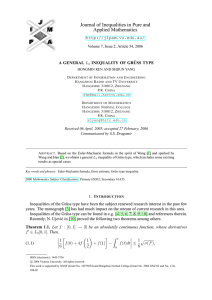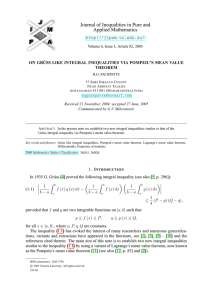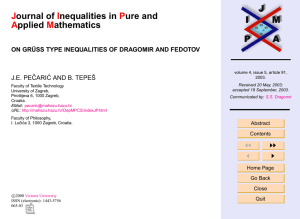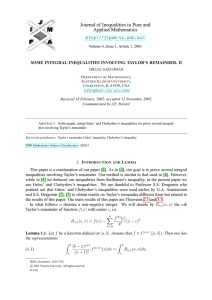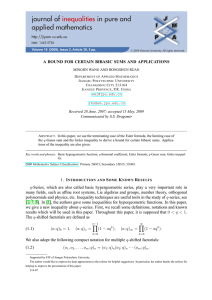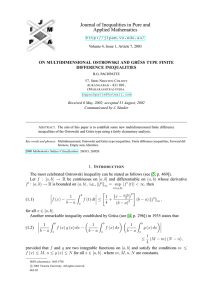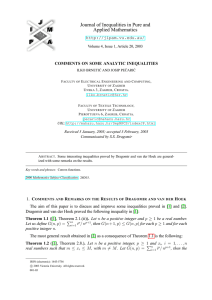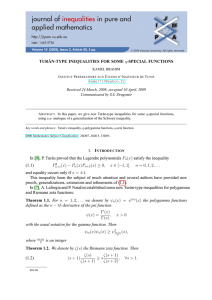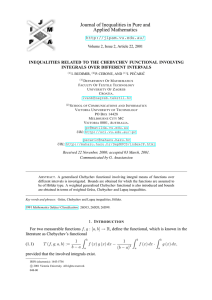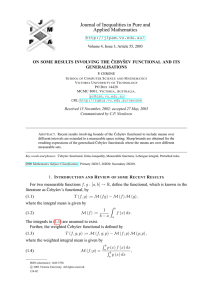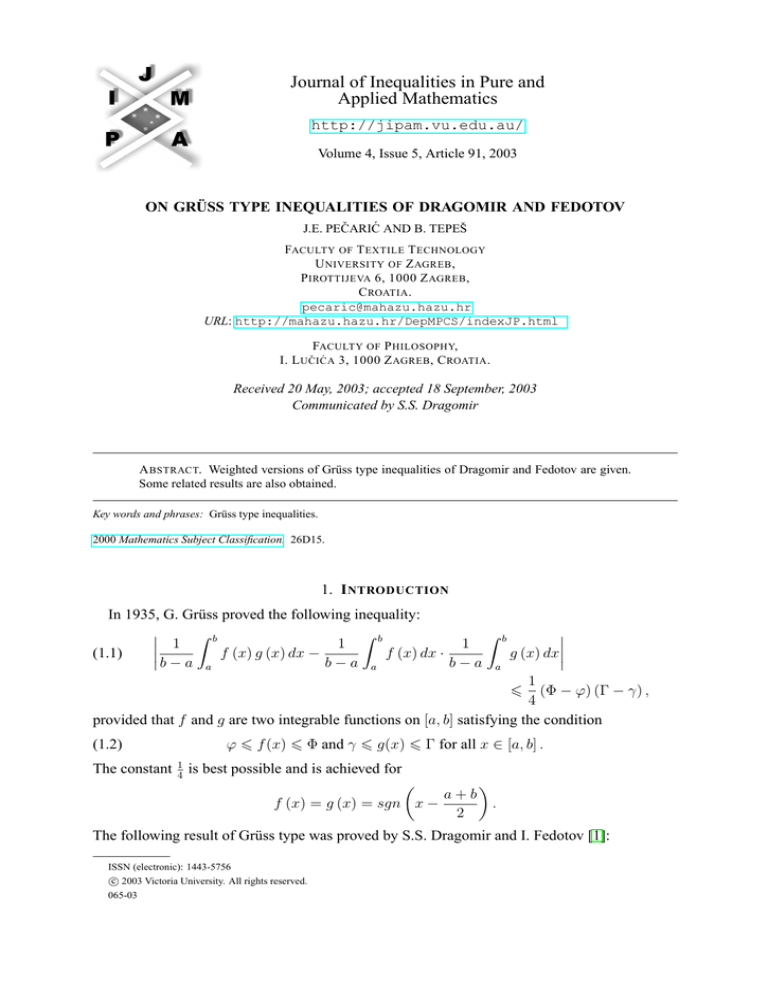
Journal of Inequalities in Pure and
Applied Mathematics
http://jipam.vu.edu.au/
Volume 4, Issue 5, Article 91, 2003
ON GRÜSS TYPE INEQUALITIES OF DRAGOMIR AND FEDOTOV
J.E. PEČARIĆ AND B. TEPEŠ
FACULTY OF T EXTILE T ECHNOLOGY
U NIVERSITY OF Z AGREB ,
P IROTTIJEVA 6, 1000 Z AGREB ,
C ROATIA .
pecaric@mahazu.hazu.hr
URL: http://mahazu.hazu.hr/DepMPCS/indexJP.html
FACULTY OF P HILOSOPHY,
I. L U ČI ĆA 3, 1000 Z AGREB , C ROATIA .
Received 20 May, 2003; accepted 18 September, 2003
Communicated by S.S. Dragomir
A BSTRACT. Weighted versions of Grüss type inequalities of Dragomir and Fedotov are given.
Some related results are also obtained.
Key words and phrases: Grüss type inequalities.
2000 Mathematics Subject Classification. 26D15.
1. I NTRODUCTION
In 1935, G. Grüss proved the following inequality:
Z b
Z b
Z b
1
1
1
(1.1)
f
(x)
g
(x)
dx
−
f
(x)
dx
·
g
(x)
dx
b − a
b−a a
b−a a
a
1
6 (Φ − ϕ) (Γ − γ) ,
4
provided that f and g are two integrable functions on [a, b] satisfying the condition
ϕ 6 f (x) 6 Φ and γ 6 g(x) 6 Γ for all x ∈ [a, b] .
(1.2)
The constant
1
4
is best possible and is achieved for
a+b
f (x) = g (x) = sgn x −
2
.
The following result of Grüss type was proved by S.S. Dragomir and I. Fedotov [1]:
ISSN (electronic): 1443-5756
c 2003 Victoria University. All rights reserved.
065-03
2
J.E. P E ČARI Ć AND B. T EPEŠ
Theorem 1.1. Let f, u : [a, b] → R be such that u is L−Lipschitzian on [a, b], i.e.,
|u (x) − u (y)| 6 L |x − y| for all x ∈ [a, b] ,
(1.3)
f is Riemann integrable on [a, b] and there exist the real numbers m, M so that
m 6 f (x) 6 M for all x ∈ [a, b] .
(1.4)
Then we have the inequality
Z b
Z b
1
u
(b)
−
u
(a)
6 L (M − m) (b − a) ,
(1.5)
f
(x)
du
(x)
−
f
(t)
dt
2
b−a
a
a
and the constant
1
2
is sharp, in the sense that it cannot be replaced by a smaller one.
The following result of Grüss’ type was proved by S.S. Dragomir and I. Fedotov [2]:
Theorem 1.2. Let f, u : [a, b] → R be such that u is L−lipschitzian on [a, b], and f is a
W
function of bounded variation on [a, b]. Denote by ba f the total variation of f on [a, b]. Then
the following inequality holds:
Z b
Z b
b
_
1
f
(b)
−
f
(a)
(1.6)
u (x) df (x) −
·
u (x) dx 6 L (b − a) f.
b−a
2
a
a
a
The constant
1
2
is sharp, in the sense that it cannot be replaced by a smaller one.
Remark 1.3. For other related results see [3].
Let us also state that the weighted version of (1.1) is well known, that is we have with condition (1.2) the following generalization of (1.1):
1
(1.7)
|D (f, g; w)| 6 (Φ − ϕ) (Γ − γ) ,
4
where
D (f, g; w) = A (f, g; w) − A (f ; w) A (g; w) ,
and
Rb
w (x) f (x) dx
A (f ; w) = a R b
.
w
(x)
dx
a
So, in this paper we shall show that corresponding weighted versions of (1.5) and (1.6) are also
valid. Some related results will be also given.
2. R ESULTS
Theorem 2.1. Let f, u : [a, b] → R be such that f is Riemann integrable on [a, b] and u is
L−Lipschitzian on [a, b], i.e. (1.3) holds true. If w : [a, b] → R is a positive weight function,
then
Z b
(2.1)
|T (f, u; w)| 6 L
w (x) |f (x) − A (f ; w)| dx,
a
where
Z
(2.2) T (f, u; w) =
a
b
w (x) f (x) du (x) − R b
a
1
w (x) dx
Z
b
Z
w (x) du (x)
a
b
w (x) f (x) dx.
a
Moreover, if there exist the real numbers m, M such that (1.4) is valid, then
Z b
L
(2.3)
|T (f, u; w)| 6 (M − m)
w (x) dx.
2
a
J. Inequal. Pure and Appl. Math., 4(5) Art. 91, 2003
http://jipam.vu.edu.au/
O N G RÜSS T YPE I NEQUALITIES OF D RAGOMIR AND F EDOTOV
3
Proof. As in [1], we have
Z b
Z b
|T (f, u; w)| = w (x) [f (x) − A (f ; w)] du (x) 6 L
w (x) |f (x) − A (f ; w)| dx.
a
a
That is, (2.1) is valid. Furthermore, from an application of Cauchy’s inequality we have:
Z
(2.4)
b
|T (f, u; w)| 6 L
Z
b
w (x) (f (x) − A (f ; w))2 dx
w (x) dx
a
12
,
a
from where we obtain
(2.5)
1
2
Z
b
|T (f, u; w)| 6 L · (D (f, f ; w)) ·
w (x) dx.
a
From (1.7) for g ≡ f we get:
1
(D (f, f ; w)) 2 6
(2.6)
1
(Φ − ϕ) .
2
Now, (2.4) and (2.5) give (2.3).
Now, we shall prove the following result.
Theorem 2.2. Let f : [a, b] → R be M −Lipschitzian on [a, b] and u : [a, b] → R be
L−Lipschitzian on [a, b]. If w : [a, b] → R is a positive weight function, then
RbRb
(2.7)
|T (f, u; w)| 6 L · M ·
a
a
w (x) w (x) |x − y| dxdy
.
Rb
w (y) dy
a
Proof. It follows from (2.1)
R b
w (y) (f (x) − f (y)) dy a
|T (f, u; w)| 6 L ·
w (x) dx
Rb
w (y) dy
a
a
R
Z b
b
w (y) |f (x) − f (y)| dy
a
6L·
w (x)
dx
Rb
w
(y)
dy
a
a
RbRb
w (x) w (x) |x − y| dxdy
6L·M · a a
.
Rb
w
(y)
dy
a
Z
b
If in the previous result we set w (x) ≡ 1, then we can obtain the following corollary:
Corollary 2.3. Let f and u be as in Theorem 2.2, then,
Z b
Z
L · M · (b − a)2
u (b) − u (a) b
f (x) du (x) −
f (t) dt 6
.
b
−
a
3
a
a
J. Inequal. Pure and Appl. Math., 4(5) Art. 91, 2003
http://jipam.vu.edu.au/
4
J.E. P E ČARI Ć AND B. T EPEŠ
Proof. The proof follows by the fact that
Z bZ b
Z b Z b
|x − y| dxdy=
|x − y| dx dy
a
a
a
a
Z b Z y
Z b
=
(y − x) dx +
(x − y) dx dy
a
Z
a
y
b
1
(y − a)2 + (b − y)2 dy
2 a
1
= (b − a)3 .
3
=
Theorem 2.4. Let f, u : [a, b] → R be such that u is L−Lipschitzian on [a, b], and f is a
function of bounded variation on [a, b]. If w : [a, b] → R is a positive weight function, then the
following inequality holds:
|T (u, f ; w)| 6 M L
b
_
g 6 WML
a
b
_
f,
a
Rx
where T (u, f ; w) is defined by (2.2), g : [a, b] → R is the function g (x) = a w (t) df (t),
(R b
)
Rb
w
(t)
(b
−
t)
dt
w
(t)
(t
−
a)
dt
a
W = supx∈[a,b] w (x) , M = max
, a Rb
,
Rb
w
(t)
dt
w
(t)
dt
a
a
Wb
Wb
and a g and a f denote the total variation of g and f on [a, b], respectively.
Proof. We have
Z
T (u, f ; w) =
b
w (x) u (x) df (x) − R b
1
Z
b
Z
w (x) df (x)
w (x) dx a
a
!
Rb
Z b
w
(t)
u
(t)
dt
=
w (x) u (x) − a R b
df (x)
w
(t)
dt
a
a
!
Z b Rb
w
(t)
(u
(x)
−
u
(t))
dt
a
=
w (x) df (x).
Rb
w
(t)
dt
a
a
a
b
w (x) u (x) dx
a
Using the fact that u is L−Lipschitzian on [a, b], we can state that:
Z
!
b R b w (t) (u (x) − u (t)) dt
a
|T (u, f ; w)| = w
(x)
df
(x)
Rb
a
w
(t)
dt
a
Z
!
Z x
b R b w (t) (u (x) − u (t)) dt
a
=
d
w (t) df (t) Rb
a
w (t) dt
a
a
! b Z
Rb
x
_
w
(t)
|x
−
t|
dt
a
6 Lsupx∈[a,b]
w (t) df (t)
Rb
w (t) dt
a
a
a
= ML
b
_
g.
a
J. Inequal. Pure and Appl. Math., 4(5) Art. 91, 2003
http://jipam.vu.edu.au/
O N G RÜSS T YPE I NEQUALITIES OF D RAGOMIR AND F EDOTOV
5
The constant M has the value
Rb
a
M = supx∈[a,b]
If we denote a new function y(x) as:
Z b
Z
y (x) =
w (t) |x − t| dt =
a
a
w (t) |x − t| dt
Rb
w (t) dt
a
x
!
.
Z
w (t) (x − t) dt +
b
w (t) (t − x) dt,
x
then the first derivative of this function is:
Z x
Z x
Z b
Z b
d
dy
=
x
w (t) tdt −
tw (t) dt +
w (t) tdt − x
w (t) dt
dx
dx
a
a
x
x
Z x
Z b
=
w (t) dt + w (x) x − w (x) x − w (x) x −
w (t) dt + w (x) x
a
x
Z x
Z b
=
w (t) dt −
w (t) dt;
a
x
and the second derivative is:
d2 y
= w (x) + w (x) = 2w (x) > 0.
dx2
Obviously f is a convex function, so we have:
!
Rb
w
(t)
|x
−
t|
dt
a
M = supx∈[a,b]
Rb
w (t) dt
a
!
y(x)
= supx∈[a,b] R b
w (t) dt
)
(R b a
Rb
w
(t)
(t
−
a)
dt
w
(t)
(b
−
t)
dt
a
= max
, a Rb
.
Rb
w
(t)
dt
w
(t)
dt
a
a
That is:
Z
!
b R b w (t) (u (x) − u (t)) dt
a
w (x) df (x)
|T (u, f ; w)| = Rb
a
w (t) dt
a
Z
!
R
b
b
w
(t)
(u
(x)
−
u
(t))
dt
a
w (x) df (x)
=
Rb
a
w (t) dt
a
Z b Rb
w (t) |u (x) − u (t)| dt
a
6
w (x) |df (x)|
Rb
w
(t)
dt
a
a
! b
Rb
_
w
(t)
|x
−
t|
dt
a
6 supx∈[a,b] w (x) Lsupx∈[a,b]
f
Rb
w
(t)
dt
a
a
= WML
b
_
f.
a
J. Inequal. Pure and Appl. Math., 4(5) Art. 91, 2003
http://jipam.vu.edu.au/
6
J.E. P E ČARI Ć AND B. T EPEŠ
R EFERENCES
[1] S.S. DRAGOMIR AND I. FEDOTOV, An inequality of Grüss type for Riemann-Stieltjes integral and
applications for special means, Tamkang J. of Math., 29(4) (1998), 287–292.
[2] S.S. DRAGOMIR AND I. FEDOTOV, A Grüss type inequality for mapping of bounded variation
and applications to numerical analysis integral and applications for special means, RGMIA Res. Rep.
Coll., 2(4) (1999). [ONLINE: http://rgmia.vu.edu.au/v2n4.html].
[3] S.S. DRAGOMIR, New inequalities of Grüss type for the Stieltjes integral, RGMIA Res. Rep. Coll.,
5(4) (2002), Article 3. [ONLINE: http://rgmia.vu.edu.au/v5n4.html].
J. Inequal. Pure and Appl. Math., 4(5) Art. 91, 2003
http://jipam.vu.edu.au/

